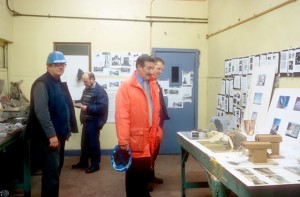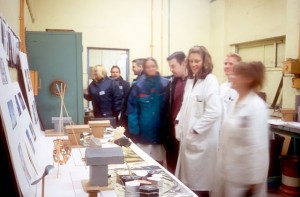Wednesday December 4th The Incidental Person in the Factory
Today before going to the Tate, I visited a number of shows in Islington, north London, an area I’m not familiar with. Getting off the Underground at Angel, I walked along the Regents Canal-an area reminiscent of the North (also reminded me of Oslo, which I visited recently), with converted warehouses and industrial units, as well as elegant Georgian terraces. I saw the Jannis Kounellis exhibition at Parasol Unit, http://www.parasol-unit.org/and the Chris Ofili show at Victoria Miro, http://www.victoria-miro.com/next door. I then went to Farringdon, an area of jewellers and metal-workers, with some of the original workshops still functioning, now a burgeoning gallery district, especially for newer/emerging galleries. I visited Rokeby, WW http://www.wilsonwilliamsgallery.com/, and the aptly-named TinType galleries http://www.tintypegallery.com/
Next week, I am going to Sheffield to visit the factory of someone who is interested in the APG – style ‘creative consultant’, the “Incidental Person” or I.P. Its very early days, but I am interested in the possibility of going into the factory myself as an IP to restage the APG idea now and see what happens.What happens will be the artwork, and an attempt to test out APG ideas now and examine its legacy.
From my research in the archive today, I am attempting to extract descriptions of the role of the I.P. from lots of documents to help with this approach to the factory.
TGA20042/3/1/1/3 1 of 4.“The Functioning of APG’s Open Brief Method. Hugh Davies, 1978.” Transcript of talk.
…..”APG’s aim is for artists to make a creative contribution to society…by bringing their creative viewpoints to bear on problems, often previously unidentified, within a selected area of society.This each artist does in his/her own personal way, so that the result will unavoidably bear his/her personal stamp, and the experience is likely to bear fruit at the same time or subsequently in purely creative work. But because there is no intention to produce a work of art in the traditional sense, the result ….is not the conclusion of an object-orientated project, but a continuing and often self-perpetuating situation in which the instigator is no longer essential…APG does not, however, supply artists to solve particular problems…rather, a relationship is set up under which an artist is given, within some necessary limitations, an open brief.”
“……During the feasibility study the I.P. is involved in the day-to-day work of those in the department or area he/she is attached to, and where a desk or office has been made available…..The I.P. is invited to participate in meetings and discussions, and to make external visits that relate to that department, either with members of it, or alone….It should also be made possible for the I.P. to explore adjacent ares or departments, where this is relevant….each I.P. will adopt a different approach…..On the basis of this feasibility study, a report is written by the I.P. (and often the host organisation as well), and a proposal is made for a more substantial placement in a precisely formulated field of interest.”
…”The open brief method does not tie the I.P. down to investigating a predetermined problem; although it would sometimes be possible to find an artist who would be interested in concentrating on such a proposal. Neither is the open brief completely vague;within a national or local government department it is necessary to be given a desk or office somewhere…..Within this self-imposed limitation the I.P. is free to choose how to conduct the feasibility study….By the time of the actual placement, a very precise project can be formulated.”
Did this work?Was this really in the spirit of the open brief? How can the brief be open if it is pre-formulated?
.…”The host organisation stands to learn new possible approaches to dealing with its normal areas of concern, and to be informed about potential future problems earlier than would normally happen”…
(This is very interesting)
“….It has also been shown that substantial sums of money could be saved immediately or at some future date, if the proposals of the I.P.s were carried out.”
….”A prerequisite for an I.P.’s free functioning is that he/she is enabled to step outside the normal departmental stratifications that usually exist. The I.P. must be able to easily reach senior people in departments or areas which normally have little contact with the one in which the I.P. is working, and also to have contact with at least one person who is much higher up in the hierarchy than would normally be possible…..In order to move sideways and upwards freely, it is essential that the host organisation permits the I.P. to work under this open brief method, and does not treat him/her simply as a temporary specialist consultant (which may be the way in which it has been possible to justify the I.P.s engagement).”
…”The possibilities that the open brief method opens up for the I.P. in making use of and contributing to the communications structure of large organisations, both internally and in relation to the outside world, are considered by APG to offer what may be the most significant influence that it can have on decision-making bodies.’
…..”The advantages of choosing an artist …is that artists are used to unbureaucratic lateral thinking, noticing problems that are elusive to define, finding imaginative solutions, often demonstrating greater practicality in dealing with and assessing unfamiliar situations than full-time civil servants, and discovering relationships between apparently unrelated areas…..”
This was very exciting, an exhilarating and fresh experiment which could have changed industry, society, cut through the very prevalent class and hierarchical divisions in British industry.
TGA 20042/3/1/1/42 From article”Modern British sculptors” by Paul Overy, Financial Times Tues Dec 9th 1969.
……”This is not just another form of patronage of the arts, but a far more radical alternative to the traditional isolation of the artist. The idea is not just to give artists free facilities and materials to produce an art object;the contact between the artist and the people working in a particular industry, whether workers or staff, could be provocative and enlightening to both sides……The artist may, in the course of pursuing his own ideas and interests, discover some new process that could be developed by the company for general use, or he might have ideas which could be of social benefit to the community.”
20042/3/1/1/44 1of 4
“Definitive vocabulary of the APG position”.
….”In the organisations the function of the I.P. is to (show pictures) using the available material establishment with which to make it…..So the I.P. is a resource and an instrument that suggests changes without doing so overtly. In Scotland the statement was put forward by the planning officer responsible that
“the artist might show us answers to problems we do not yet know to exist”.
220042/3/1/1/44 3 of 4 “Distinctions and Glossary.1978.The “Incidental” Person.
…..”Short of APG’s brief, an expectancy factor raised in using an established term such as “Community artist” carries with it a relatively predetermined level of result.The community artist has already become categorised into a ‘help’ orientated function.There is nothing wrong with this but art is not necessarily help.……The I.P. is not a community worker employed to help with existing, already diagnosed problems.”


